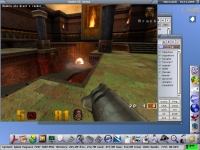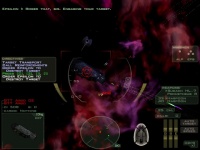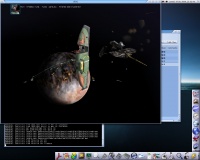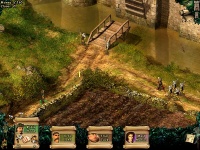Retour sur la page principale

Virtual Grand Prix 2 with HD textures
L'un des jeux les plus notables disponibles sur MorphOS est sans aucun doute Virtual Grand Prix 2, publié par Alassoft. C'est une simulation de Formule 1 très réaliste (probablement l'une des plus réalistes toutes plateformes confondues), avec de beaux graphismes utilisant l'accélération 3D, et sachant gérer les périphériques analogiques via la pile USB Poseidon et la nouvelle lowlevel.library. La version MorphOS a été réalisée peu de temps après les versions Mac et Windows, en raison des fortes racines amigaïste du programmeur principal Paolo Cattani. D'ailleurs, on peut noter que la version MorphOS est complétement gratuite. Le jeu inclus la plupart des vrais circuits, très bien réalisés, et facilement reconnaissables. Ceux qui ne sont pas inclus ont été créés par des utilisateurs et peuvent être trouvés sur internet en tant que packages additionnels. Le jeu est rapide et jouable même sur une configuration de base (y compris sur une Efika 400MHz avec seulement 128 Mo de RAM). De plus, le jeu a été conçu avec le maximum de liberté permettant de personnaliser les graphiques ce qui a permis la création de
textures de qualité plus élevées et de circuits plus détaillés qui peuvent ainsi être utilisés dans la version MorphOS. En conséquence de quoi, ce jeu est en même temps agréable sur les machines bas de gamme et cependant peut être l'un des plus avancés graphiquement disponible sur MorphOS.
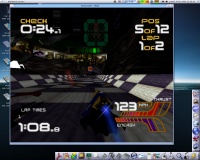
Wipeout 2097 running in a window
Other commercial games available for MorphOS include all those released for classic Amiga computers with PowerPC CPUs. These include the
Wipeout 2097 port released by Digital Images and the
Heretic 2 port released by Hyperion Entertainment. The former was a very nice version of the famous game, that took the best from the PlayStation version (the most playable one) and the Windows version (the higher resolution graphics, for instance), making the Amiga conversion the best incarnation of them all.
Wipeout 2097 is a WarpUp executable, using the Amiga
Warp3D software for graphic acceleration, but, as usual, MorphOS users have little to worry about, since the OS includes
Goa3D, a wrapper for the Amiga's Warp3D.
Wipeout 2097 runs transparently, both in full screen and in a window on the desktop, supports graphics and audio boards not supported by the classic Amigas, and can be played using USB controllers. It is of course faster than it ever was on any classic Amiga.
Many open source games have been ported to MorphOS, including several commercial games whose sources have been released, like id Software masterpieces
Wolfenstein 3D,
Doom,
Doom II,
Quake,
Quake II and
Quake III. The
Quake series supports 3D acceleration, and in particular in the case of the old first
Quake episode, even the better looking versions
Fodquake,
Fuhquake,
GLQuake and
BlitzQuake have been ported. All the games run quite fast in high resolutions thanks to the 3D acceleration.
Speaking of first person shooters, also Cube, AlephOne and the freeware game Warsow have been released. Warsow is probably graphically the most complex project ever ported to MorphOS (even though it is based on the old Quake II engine), and in fact might not run at a decent speed on a G3 CPU with Voodoo graphics. But it is also one mean to show that better hardware does not sit unused with MorphOS.
Other open source projects ported include the icculus.org games
Freespace 1 and
2 (that of course need the original versions to be fully operational), and games like
NeverBall/NeverPutt and the 3D pool game
FooBillard.
Open Transport Tycoon Deluxe, the open source reimplementation of Microprose's
Transport Tycoon Deluxe, is available, too. The MorphOS version (that, as well as all the other versions, needs the original game files to run) is synchronised with the official releases. This means that it is available directly from the project home page, since MorphOS support was inserted into the main source tree.
Open Transport Tycoon Deluxe makes use of the
PowerSDL.library to run. This library (whose special features are described in the section dedicated to
MorphOS key applications) facilitated already the porting of dozens of free and open source SDL games to MorphOS. A recent addition to this list of ports is the space real strategy game called
HomeWorld, that is probably the first game requiring at least MorphOS 2.1. Also in this case the user needs the original PC version to be able to play this game on his MorphOS system. Other open source real time strategy games are available, notably
Warzone 2100, while fans of turn based strategic games have the chance to get some hours of fun with the famous
Battle for Wesnoth.
In the past at least one commercial software house had been releasing specific ports for MorphOS, and that is RuneSoft (formerly known as Epic Interactive). They released
Knights and Merchants and
Robin Hood.
Knights and Merchants is a strategic game in the fashion of
The Settlers, just with much better graphics than the first release of that famous saga which started on the Amiga in 1993.
Robin Hood, on the other hand, is a strategic arcade game in
Commandos style, originally released on PC by Spellbound. The graphics and audio are probably the best ever seen on MorphOS in a 2D game, and, even if a bit demanding, were carefully optimised to run smoothly even on a G3 Pegasos. RuneSoft had more games in the pipeline, and hopefully they will resume their support to MorphOS if they find again some viability in this market thanks to the broader hardware availability brought by the support of PPC Macintoshes. They always release demo versions of their conversions: therefore users can test the game, before voting with their wallets for more support.
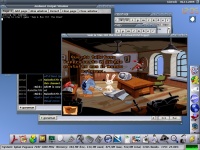
Sam & Max Hit the Road on MorphOS, courtesy of ScummVM
Of course, on MorphOS the user can entertain himself not just with more or less native executables: there are also many emulators and virtual machines. One of the best known is
ScummVM, the free reimplementation of the engine behind most Lucas Arts/Lucas Games adventures. The newest versions are also compatible with some games from other vendors (just like
Beneath a Steel Sky or
Broken Sword from Revolution) and luckily available for MorphOS, too. The nice thing about this is the possibility to run some of these adventures that were never published in an Amiga-like environment (Lucas Arts left the Amiga scene after
Indiana Jones 4). The engine works flawlessly and nicely, and these games, with their retro appearance, are always fun to play.
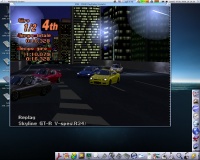
PlayStation emulator FPSE
The category of the "real" emulators includes
Genesis Plus and
SMS Plus for the Sega consoles,
SNES 9x for the Super Nintendo (or Super Famicom) console,
VICE for the VIC series of Commodore home computers,
MAME for the arcade machines... All of these are quite good at their work and are not just fast ports, since, for instance, they all support overlay (in order to enable transparent real time resizing of the window) and USB joypads. A nice addition is
FPSE, the PlayStation emulator that supports even 3D graphic acceleration, enabling the possiblity to play games at video resolutions higher than the original.


